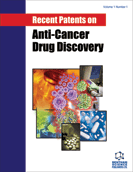Abstract
Kinase inhibitors are among the fastest growing class of anti-cancer therapies. One family of kinases that has recently gained attention as a target for treating malignant disorders is the Tec kinase family. Evidence has been published that one member of this family; the Bmx kinase, may play a role in the pathogenesis of glioblastoma, prostate, breast and lung cancer. Bmx has also shown potential as an anti-vascular therapy in combination with radiation or as a sensitizer to chemotherapeutic agents. Therefore, several companies such as Pharmacyclics, Avila Therapeutics, Merck and Co., Metaproteomics, IRM, and Moerae Matrix have developed compounds or peptides that function as Bmx kinase inhibitors. These companies have subsequently been issued patents for these inhibitors. Additionally, it has been shown that current clinical stage EGFR inhibitors can irreversibly inhibit Bmx, suggesting these compounds might be rapidly moved to clinical trials for other malignancies. This review will discuss current patents issued since 2009 that contain data specifically on inhibition of the Bmx kinase, and will also discuss the scientific literature that suggests their potential application as therapeutics in the treatment of the aforementioned malignancies.
Keywords: Bmx, breast cancer, Btk, Etk, glioblastoma, kinase inhibitor, lung cancer, prostate cancer, Tec.
Recent Patents on Anti-Cancer Drug Discovery
Title:Mini-Review: Bmx Kinase Inhibitors for Cancer Therapy
Volume: 8 Issue: 3
Author(s): John S. Jarboe, Shilpa Dutta, Sadanandan E. Velu and Christopher D. Willey
Affiliation:
Keywords: Bmx, breast cancer, Btk, Etk, glioblastoma, kinase inhibitor, lung cancer, prostate cancer, Tec.
Abstract: Kinase inhibitors are among the fastest growing class of anti-cancer therapies. One family of kinases that has recently gained attention as a target for treating malignant disorders is the Tec kinase family. Evidence has been published that one member of this family; the Bmx kinase, may play a role in the pathogenesis of glioblastoma, prostate, breast and lung cancer. Bmx has also shown potential as an anti-vascular therapy in combination with radiation or as a sensitizer to chemotherapeutic agents. Therefore, several companies such as Pharmacyclics, Avila Therapeutics, Merck and Co., Metaproteomics, IRM, and Moerae Matrix have developed compounds or peptides that function as Bmx kinase inhibitors. These companies have subsequently been issued patents for these inhibitors. Additionally, it has been shown that current clinical stage EGFR inhibitors can irreversibly inhibit Bmx, suggesting these compounds might be rapidly moved to clinical trials for other malignancies. This review will discuss current patents issued since 2009 that contain data specifically on inhibition of the Bmx kinase, and will also discuss the scientific literature that suggests their potential application as therapeutics in the treatment of the aforementioned malignancies.
Export Options
About this article
Cite this article as:
Jarboe S. John, Dutta Shilpa, Velu E. Sadanandan and Willey D. Christopher, Mini-Review: Bmx Kinase Inhibitors for Cancer Therapy, Recent Patents on Anti-Cancer Drug Discovery 2013; 8 (3) . https://dx.doi.org/10.2174/15748928113089990043
| DOI https://dx.doi.org/10.2174/15748928113089990043 |
Print ISSN 1574-8928 |
| Publisher Name Bentham Science Publisher |
Online ISSN 2212-3970 |
 69
69
- Author Guidelines
- Bentham Author Support Services (BASS)
- Graphical Abstracts
- Fabricating and Stating False Information
- Research Misconduct
- Post Publication Discussions and Corrections
- Publishing Ethics and Rectitude
- Increase Visibility of Your Article
- Archiving Policies
- Peer Review Workflow
- Order Your Article Before Print
- Promote Your Article
- Manuscript Transfer Facility
- Editorial Policies
- Allegations from Whistleblowers
Related Articles
-
Ghrelin and Cardiovascular Diseases
Current Cardiology Reviews Carotenoids and Prostate Cancer Risk
Mini-Reviews in Medicinal Chemistry Role of Endogenous Androgen Against Insulin Resistance and Athero-sclerosis in Men with Type 2 Diabetes
Current Diabetes Reviews The Role of Histone Demethylase GASC1 in Cancer and its Therapeutic Potential
Current Cancer Therapy Reviews Inhibition of Human Melonoma Cell Proliferation Using Small Molecule Uracil-DNA Glycosylase Inhibitors
Letters in Drug Design & Discovery Alcohol Induced Hepato Cardiotoxicity and Oxidative Damage in Rats: The Protective Effect of n-butanol Extract of Green Tea (Camellia sinensis (L.) Kuntze)
Cardiovascular & Hematological Disorders-Drug Targets Thymoquinone Anticancer Discovery: Possible Mechanisms
Current Drug Discovery Technologies Hormetic Potential of Sulforaphane (SFN) in Switching Cells’ Fate Towards Survival or Death
Mini-Reviews in Medicinal Chemistry Epidemiology, Clinical Presentation and Treatment of Mucosal Melanoma
Clinical Cancer Drugs Characterization of Pharmaceutical IgG and Biosimilars Using Miniaturized Platforms and LC-MS/MS
Current Pharmaceutical Biotechnology A Dual Role of Cyclin E in Cell Proliferation and Apotosis May Provide a Target for Cancer Therapy
Current Cancer Drug Targets Pomegranate Extracts and Cancer Prevention: Molecular and Cellular Activities
Anti-Cancer Agents in Medicinal Chemistry New Generation of Oncolytic Herpes Virus
Current Cancer Therapy Reviews Evaluation of the Binding Affinity of a Gonadotropin-Releasing Hormone Analogue (GnRH-a) Buserelin through <i>In silico</i> and <i>In vivo</i> Testing in <i>Clarias magur</i>
Current Proteomics MiRNA153 Reduces Effects of Chemotherapeutic Agents or Small Molecular Kinase Inhibitor in HCC Cells
Current Cancer Drug Targets Construction and Analysis of mRNA and lncRNA Regulatory Networks Reveal the Key Genes Associated with Prostate Cancer Related Fatigue During Localized Radiation Therapy
Current Bioinformatics Epigenetic control of cardiovascular health by nutritional polyphenols involves multiple chromatin-modifying writer-reader-eraser proteins
Current Topics in Medicinal Chemistry Acetylation Control of Cancer Cell Metabolism
Current Pharmaceutical Design Specialisation of the Tropomyosin Composition of Actin Filaments Provides New Potential Targets for Chemotherapy
Current Cancer Drug Targets Synthesis of Unsymmetrical C5-Curcuminoids as Potential Anticancer Agents
Letters in Drug Design & Discovery


























